By Benjamin Nobel, March 23, 2021

Today I’m going to dig into the various versions of Todd McFarlane’s 1990 classic, Spider-Man #1 (a “Classic Cover” if there ever was one!). Between our various go-to sources of comic book information, it seems we have a fairly good picture of how many copies of each different original August 1990 version were sold… except for the newsstand version, which the hobby doesn’t seem to have a good handle on, almost as if its sales were a mystery (which in many ways they were) — so in this post, I hope to explore further, in order to learn more about the relative rarity (and relative high grade rarity) of the newsstand copies versus the other types.
To begin, let’s review the various types out there (and we’ll stay in the 1990s — various reprints subsequently occurred including a flood of them last year, and I will be ignoring those). This review can be more complicated than it needs to be, simply because each different comic book “authority” has their own internal categorizations (and the prominent comic shops have their own categorizations as well). Often this can mean that distinctly printed types can be overlooked/ignored by a given authority: In fact, if we went just by the variant names that appear on the CGC census for example, we might (falsely) conclude that 1st print newsstand copies don’t even exist!
CGC’s census has the following entries for Spider-Man #1 (as of this writing):
- “Regular” copies (no variant name on the label) = 6,458 copies presently on census.
- “Gold Edition” copies = 3,980 copies presently on census
- “Platinum Edition” copies = 1,727 copies presently on census
- “Poly-Bagged Edition” copies = 922 copies presently on census
- “Poly-Bagged Silver Edition” copies = 1,136 copies presently on census
- “Silver Edition” copies = 9,415 copies presently on census
- “UPC Gold Edition” copies = 571 copies presently on census
| “UPC Gold” Copies — Let’s Start By Looking At These |
Interestingly, CGC does recognize one type with a newsstand bar code on it… and that’s the second print (gold cover) newsstand/UPC type… which for years CGC denoted without any indication that it was actually a second printing!
The terminology “UPC Gold Edition” was entirely of CGC’s own choosing, as this terminology appears nowhere in the indicia itself. Rather, CGC appears to have chosen it to delineate the Gold cover copies with newsstand UPC codes, as being distinct from the direct edition “regular” Gold cover copies (i.e. the ones with logos in place of the bar code — if you are unfamiliar with the difference between direct edition and newsstand comics, then I suggest you pause here, and read this post first before you continue). To show you what the indicia looks like for the Gold UPC copies, below is an eBay listing I found of a Gold UPC copy, where as you can see from the row of picture icons, the seller has helpfully included an indicia photo.

Below is their indicia photo, where as you can see, it says nothing about “UPC Gold Edition” anywhere; and it is clearly denoted as a “Second Printing”:

Here’s a zoom-in with the Second Printing notation circled:

Despite being a second printing, for years CGC’s labeling treatment had zero indication anywhere that the Gold UPC version of the issue was indeed a second printing (which unfortunately led many collectors to falsely assume that it was a first printing). Below is an example of CGC’s old/past labeling treatment:

Years later, CGC began to place the note “Indicia states ‘Second Printing'” on the right-hand side of the label:

[The same goes for “regular” (direct edition) gold copies as well: CGC used to label them without any second printing indication, but then added the same note shown above, onto those labels as well.]
At this point, you may find yourself asking, “why does CGC give gold cover copies with newsstand UPC codes their own census entry (but meanwhile no census entry for first print copies with UPC codes)?” I’d wager that part of the answer to this question has to do with what appears in the Overstreet price guide. Let’s explore that further, in the next section.
| Second Printing (“Gold”) Copies — The Print Run Numbers |
Although the newsstand bar code would lead us to assume that such gold-cover copies were distributed on newsstands, as it would turn out, Marvel inked a deal with Walmart whereby Walmart took the entire print run of these for themselves as an exclusive, and therefore none were distributed across the traditional newsstand channel. And according to Overstreet, the size of this run given to Walmart was a mere 10,000 copies (leading Overstreet to include a distinct high-value entry in their price guide for such copies — and that distinct entry and high value perhaps helps to explain why CGC, in turn, would create a distinct entry in their census):

I find this absolutely fascinating to think about from the “business perspective” of imagining Marvel weighing the decision to make this deal with Walmart (versus going to the traditional newsstand channel with their second print Gold cover copies printed with UPC codes). To Marvel, a firm sale of 10,000 copies to Walmart as an exclusive (at whatever price they negotiated) must have been judged as a “superior” deal versus going the traditional newsstand route. Perhaps this helps shed some amount of light on what sales “might have been” had they gone the newsstand route instead — i.e. if Marvel had expected they could sell 20,000 or 40,000 or 60,000 second print copies on newsstands, would they have still made this Walmart deal??
Newsstand copies we must remember — unlike their prevalent direct edition counter-parts — were returnable copies by the very nature of the newsstand distribution channel: publishers would print out a distinct print run batch for newsstands (to distinguish them from non-returnable direct editions) and then send them out to newsstands where each copy would sit waiting for a buyer to come along. And if no buyer ever came, then the unsold copies were then returned for credit, and typically pulped/recycled forward.
This fascinating dynamic also makes newsstand sales issue-by-issue a fun mystery: how many newsstand copies did the publisher ultimately sell for the issue in question?? That all depends on the sell-through for that book on the stands, which could vary considerably issue by issue. Based on newsstand rarity discussions and estimates we have seen, we might look at the 1990 estimate given by Chuck Rozanski (who played an important insider role in the advent of direct editions) for Marvel’s 1990 direct edition sales (overall) at 85% in that year (versus newsstand at 15% of sales). This estimate would imply, for example, that for a given typical issue with total sales of 500,000 copies, 425,000 of those sales would be expected to be direct edition, and 75,000 would be expected to be newsstand.
As it turns out, second print (Gold cover) direct edition sales of Spider-Man #1 fell right in that range of 425,000 according to Overstreet:

So therefore I would interpret the situation as Marvel giving up the chance for newsstand sales of “an estimated up to 75,000” second print (gold cover) copies, in exchange for a firm sale of 10,000 copies to Walmart as an exclusive. While part of any business decision is non-monetary (Marvel may have seen value in “building a relationship” with Walmart), this situation still leaves me wondering just how well 1st print copies sold on newsstands given that Marvel gave up the chance to sell their 2nd print newsstand copies the traditional way, in exchange for the firm sale at 10,000 copies.
| Green/1st Print “UPC” Copies — What Were The Numbers?? |
So while we have good information on the second print copies that carried newsstand bar codes, how about the 1st print newsstand copies… how well did they sell? Unlike the gold UPC coded copies, the first print newsstand copies were sold in polybags, and they look like this:

Unfortunately, Overstreet gives no estimate whatsoever for the sales numbers on these first print newsstand copies with UPC codes; however, they do give us some “clues,” in the form of print run numbers for other poly-bagged versions. In addition to their sales of regular unbagged direct edition copies, Marvel apparently printed 125,000 direct edition copies and stuck those in bags too — and the “webbing” on the cover looks to have been given a slightly different shade of color (more purple). Overstreet gives the polybagged direct editions their own line item in the guide, and reveals their print run as follows:

Interestingly, Overstreet has separate value lines for: the polybagged regular direct edition copies; the un-polybagged regular direct edition copies; and also for UPC coded polybagged copies. And, perhaps tellingly — since Overstreet appears to be factoring in print run differences into their guided values for other types — they give the “UPC polybagged” copies the same guided value as the “regular polybagged” (direct edition) copies. Interesting, right? Already, that leads me to wonder if the UPC coded polybagged copies had sales in the same 125,000 neighborhood, in-line with the “regular” (direct edition) polybagged copies?
The “regular” polybagged direct edition copies look like this (notice the logo in place of a bar code, and see if you agree that the color of the webbing looks more purple):

And then Marvel also sold a known number of silver copies in poly-bags as well; and interestingly in the case of those, rather than bag some number of copies out of the regular silver direct edition print run, instead, Marvel cleverly (greedily?) sold those special silver polybagged copies for 25 cents more… and to do this, they placed a $2 price on the plastic bag and then did a distinct print run batch of silver copies with the cover price edited out of the cover itself:
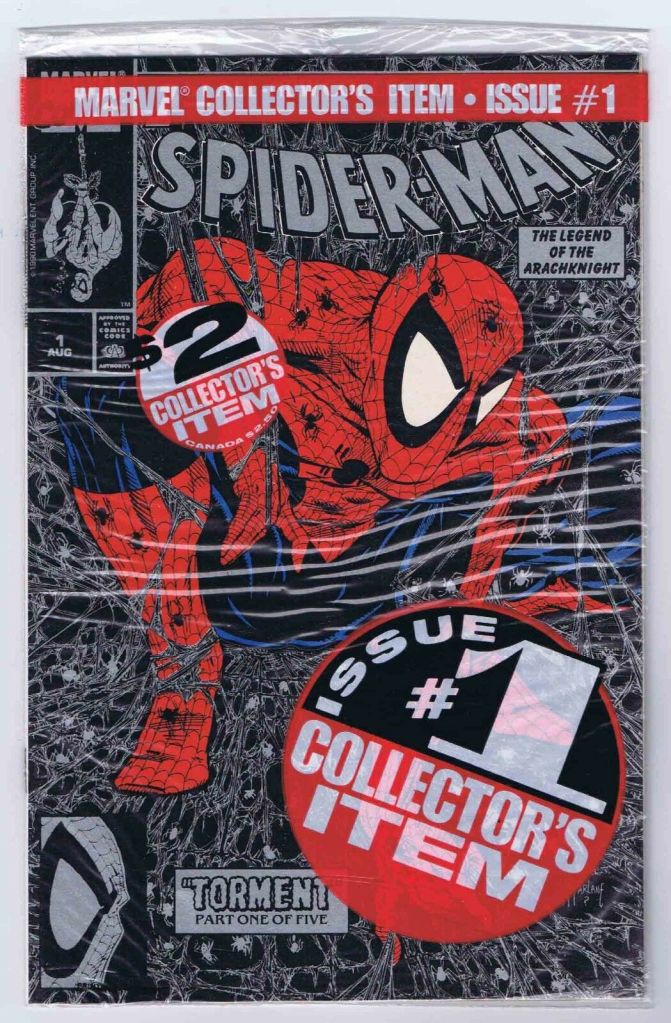
Here’s a close-up of the price box comparing a polybagged silver copy like the above, versus a regular silver copy:

And according to Overstreet, Marvel sold 125,000 of these silver polybagged copies too:

So if we know that Marvel sold 125,000 direct editions in polybags, and we know that they also sold 125,000 of these no-cover-price silver copies in polybags via direct sale, we’re still left with the question of how many newsstand copies in polybags were likely to have been sold — but it is really starting to seem that Marvel liked the number “125,000” for these polybagged batches, does it not?
| Further Clues: CGC’s Treatment & Marketplace Observations |
As it so happens, CGC’s bizarre treatment / organization of their census entries for Spider-Man #1 actually has a “side-effect” that should help us explore the newsstand sales numbers mystery, because referring back to the list of census entries shown before, they have both a “Poly-Bagged Silver Edition” census entry and a “Poly-Bagged Edition” entry; and as it turns out, that “Poly-Bagged Edition” entry encompasses (lumps together) the direct editions that originally were sold in poly bags and the newsstand editions with UPC codes as well!
When CGC was asked about how to submit polybagged copies to them for grading, this was their answer:

This creates a comical situation where CGC does not discern direct edition versus newsstand first print copies with distinct census entries, but, CGC will encapsulate a given copy under the “Poly-Bagged Edition” variant census category if they know it used to be in a polybag; whereas the exact same comic could be categorized under the standard census category if its polybag-or-not origin is unknown to CGC!
And this polybag-vs-un-polybagged treatment appears to be the same for both direct edition as well as newsstand copies (even though all newsstand copies originally would have originated in polybags), i.e. looking in the marketplace, it is readily possible to find CGC graded newsstand copies both with the “Poly-Bagged Edition” label and also without it… Presumably with the former having been submitted to CGC still inside the polybag, and the latter having already been snipped out by its submitter. Here’s a side-by-side example of two newsstand copies I found listed — remember the comics themselves are 100% physically identical to each other because they are out of the same print run batch — and yet they received two different CGC labels based on “polybag status” at submission time:
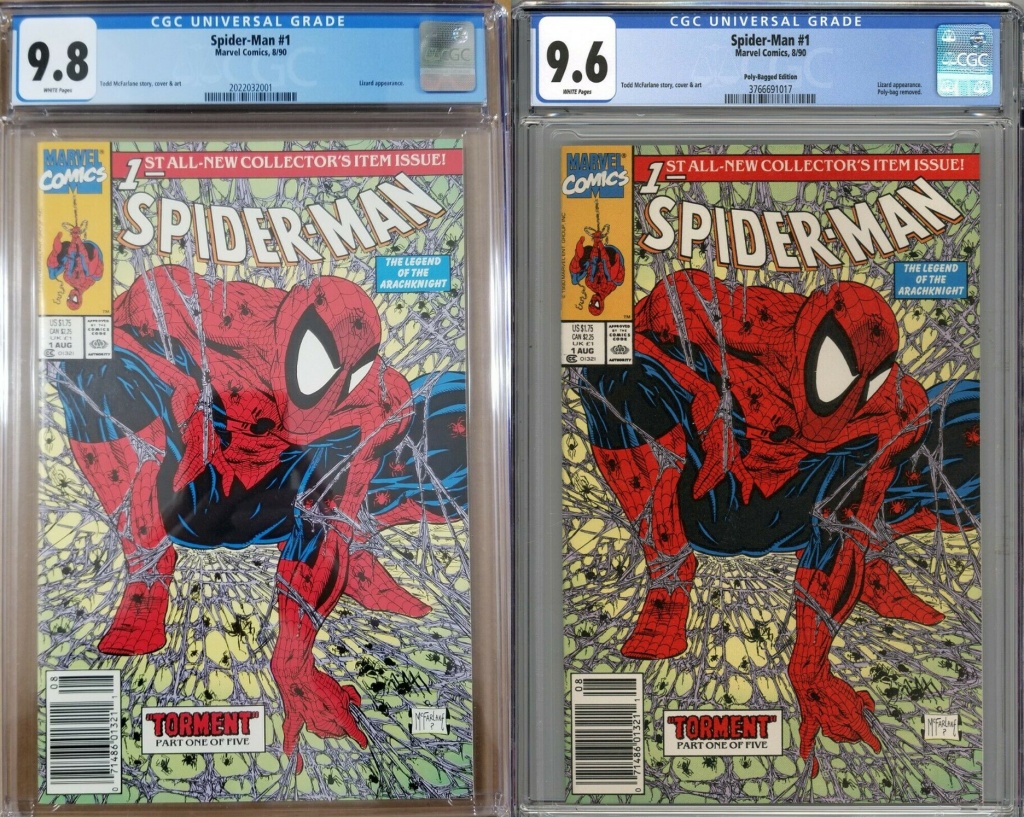
I want to talk a bit more, later on, about the treatment of polybagged comics in general; but for now, when it comes to the exploration of the newsstand numbers, what this CGC treatment does for us is to actually help us out quite a bit… Because knowing that CGC will lump together both the newsstand and direct edition types under the “Poly-Bagged Edition” category for books submitted to them in poly-bags (and that unbagged copies can be given regular/non-variant labels) means that we can study the marketplace availability of CGC graded copies that were given the Poly-Bagged Edition variant designation and then among those, observe how many are newsstand, versus how many are direct edition; and since we know from Overstreet that the print run of direct editions that were polybagged was 125,000, and we also know that that the silver polybagged copies were also given a print run of 125,000, this print run knowledge for two out of the three, combined with a study of marketplace availability under the Poly-Bagged Edition label, can in turn help us to calibrate our thinking about the newsstand numbers!
I searched eBay for CGC graded poly-bagged copies using the search string “Spider-Man 1 CGC Poly-Bagged”, looking both at the active listings and also the sold listings sections. While today is just one point in time, this study should provide helpful ratios of recently sold plus currently available copies, that originated in polybags. Here below are my screen-captures, followed by my counts.


I count as follows: 20 Silver Polybagged CGC copies, 13 Direct Edition Polybagged CGC copies, and 12 Newsstand Polybagged CGC copies. Keeping in mind that for the silver copies the lack of a cover price makes them discernable to CGC as that type regardless of whether the submitter opens the polybag or CGC does (versus with the green-cover polybagged copies where CGC can instead categorize them under the main/regular census entry all depending on submitter behavior), this would argue for the silver polybag census count to be “naturally elevated” versus the regular polybag census count. Thus it is not surprising to me that I counted 20 of these silver ones, versus 13 direct edition poly-bagged copies, even though both are known to Overstreet to have had the same 125K print run — I think part of the explanation for the difference here is that some of the direct edition poly-bagged copies are simply not making it onto the polybag edition census entry.
But the comparison that is the most important to us here, in the context of our exploration into the newsstand numbers, is that I counted roughly the same number of direct edition and newsstand copies that had been labeled under that Poly-Bagged Edition census category — thirteen versus twelve, pretty much right in line!
To me this all suggests that a good best guess would be that Marvel printed out 125,000 silver copies for polybags, printed another 125,000 copies for regular direct edition polybags, and then I’m going to wager a guess that they polybagged 125,000 copies for newsstand distribution as well. It could also be the case that they sent more than this to newsstands and some portion never sold. [Ultimately what we really care about as collectors is how many were sold (and the survivorship characteristics from there) — if Marvel printed and sold all 125,000 copies that would leave us in the same situation as if they had printed 250,000, sold half, and pulped the other half, or printed 375,000 and only sold a third of them, etc. etc., you see what I mean I hope].
And I’m going to further guess that Marvel experienced a well-above-average sell-through on the newsstands for this particular issue, between the gorgeous cover artwork, the big “#1” and the fact that the polybag looked so enticing as a point-of-purchase item… I’d bet that lots of newsstand-goers who wouldn’t have normally bought such a comic to read it, would meanwhile have grabbed one or more of these Spider-Man #1’s figuring they’d squirrel it away in hopes of future collectible value.
But unlike direct editions which would have been handled with great care by the comic shops that received them, and stored away in comic bags and boards by the collectors who took them home, the polybagged newsstand copies would have experienced the rough handling that newsstand-distributed comics are notorious for — and indeed, many of the newsstand copies of Spider-Man #1 that I have seen that are still within their original polybags are nonetheless creased along the spine (typical crease spot I’ve seen is usually at the top left within the orange Marvel Comics box), and/or have indentations where they hit the rack along the cover edge, and, I even spotted the below copy advertised as “brand-new, sealed, never opened!” but with obvious water stains on the back cover:
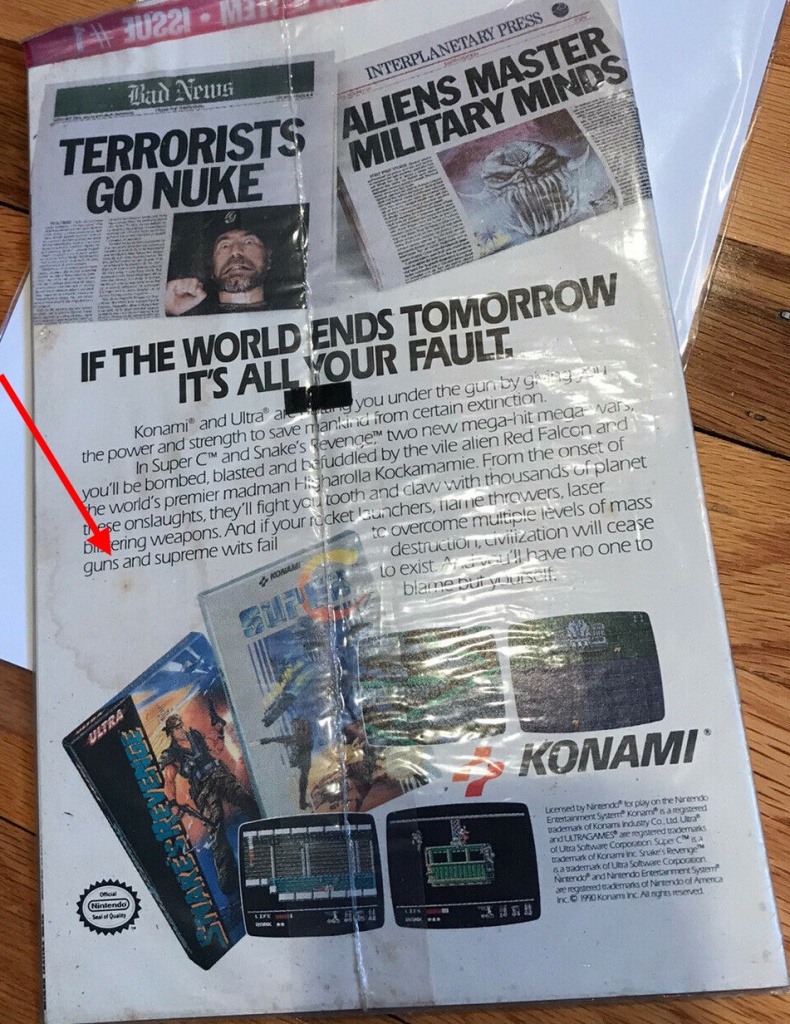
And please notice something else, too, about that back cover picture shown above: notice the “ridge” of plastic that sticks up along the center, where the plastic comes together and forms a seal. For even the most well-preserved newsstand copies where the original buyer placed the whole polybag into a comic book bag with a backing board, this plastic ridge still presses a bend along the entire back cover. This back cover bend is the case for every newsstand copy I have examined so far, and I really don’t see how any of them could have avoided it. Worse, for any copies stored in a stack, the plastic ridge also presses into the front cover of the copy below it! Here’s an example back cover that I am holding at the right angle against the light, so that the bend is illuminated:
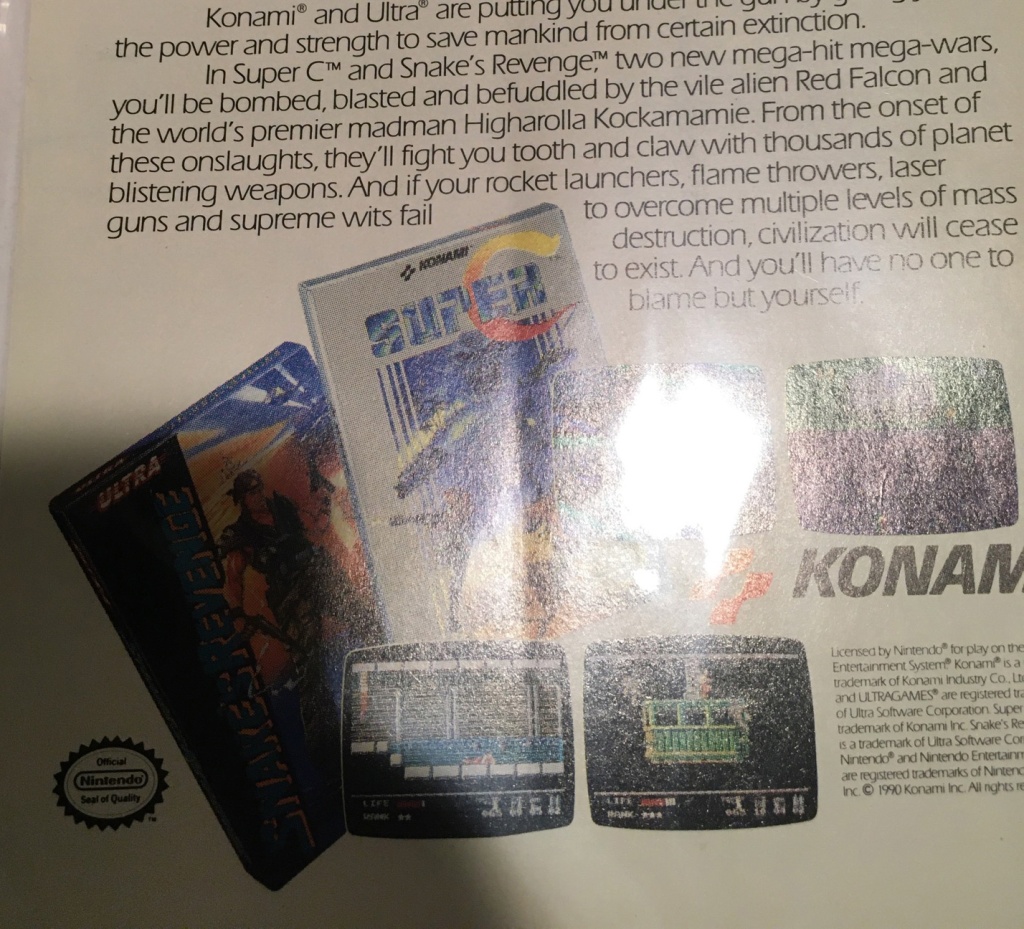
So although the “natural temptation” would be for any owner of a still-sealed polybagged newsstand copy of Spider-Man #1 to think along the lines of logic of “it is still sealed in its original bag, therefore it is still in mint condition” (and many owners are indeed advertising their copies for sale as mint or near-mint), the reality of the situation is that most of these are likely in a more-realistic 8.0 and under; I think that Comics To Astonish has it right, with their method of listing their own polybagged newsstand copies, which are all still sealed and yet are (truthfully) advertised as “7.5 or better”:

As for the lucky newsstand copies that received the very best possible storage from their owners, and those owners are later tempted to send them in for grading (thinking to themselves, this is still sealed, and I’ve kept it in a comic bag with backing board since 1990, so it must be mint, right?), I have to imagine these are most likely going to be actually surviving “as is” at 9.2 grades at best. I found the below CBCS example (CBCS happily makes its grading notes public, enabling us to see them) and the single note inputted by the grader for this example is: “poly-bag bend front & back cover” (so apparently “poly-bag bend” is so common as to be a grading industry term):
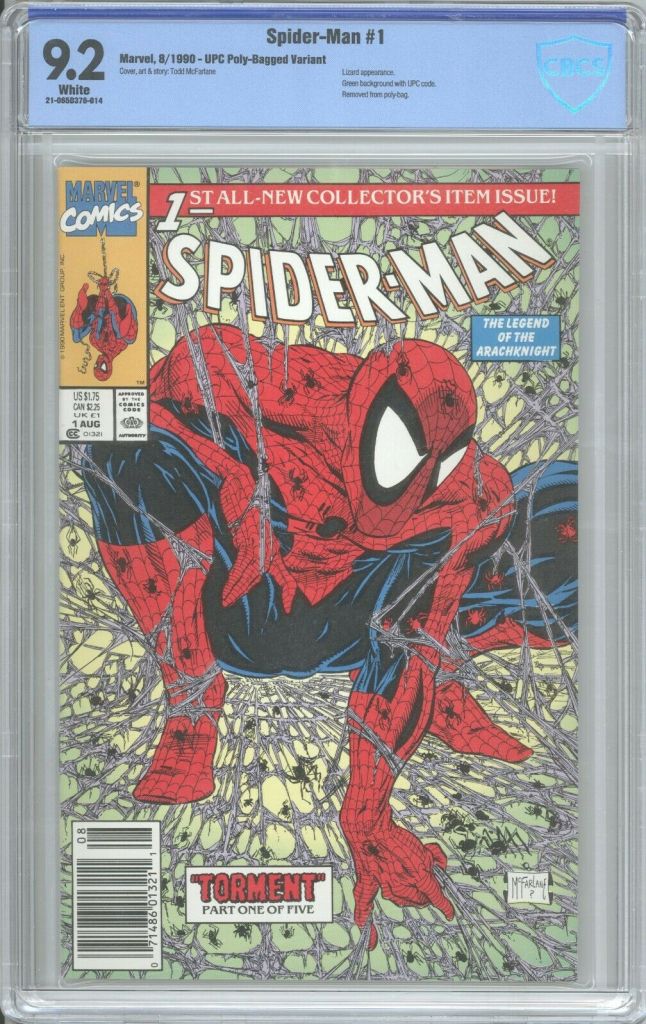
Given these condition challenges for surviving newsstand copies, how is it that 9.6 and 9.8 CBCS and CGC-graded newsstand copies are sometimes seen in the marketplace? I think the answer is either that (a) the original owner removed the book from its polybag back in 1990 and carefully stored it in a bag and board ever since, or, (b) probably more likely: the book has undergone a “pressing” to straighten out the polybag bend, ahead of being graded.
CBCS has a census of their own, and it is interesting to note that their entry for “UPC Poly-Bagged Variant” shows just seven copies in the top two grades of 9.6 and 9.8, and meanwhile their entry for “Gold UPC Variant” shows just six copies in those grades. Not much of a difference there between the first and second print newsstand copies, when comparing the highest grades! That being said however, CBCS’s census does not indicate when (in time) the “UPC Poly-Bagged Variant” census entry was created (it is possible they may have only added it once they began to recognize newsstand comics broadly, back in 2017), so it may not be fair to compare those two census entries against one another, if one of the two has only been accumulating copies since 2017.
However, what is definitely fair to look at with regard to this “UPC Poly-Bagged Variant” CBCS census entry, is the breakdown of the various grades within the census entry — for example, the ratio of 9.6-and-up copies, to the total submitted. And here, we find that just 13.5% of total copies submitted that have been given this “UPC Poly-Bagged Variant” classification by CBCS have received a 9.6 or higher grade. For contrast, fully 74% of the direct edition silver copies on CBCS’s census are 9.6-and-up!
And to add to the overall picture for comparison, how about the polybagged silver copies, the ones with the cover price edited out? These would have had careful handling via their direct sales distribution and similarly would have been handled with care by the collectors who took them home — but they’d still have that “polybag bend” condition problem if stored in their original bags. And with no cover price, presumably it is much less common that these get mis-labeled as regular silver copies. And for these polybagged silver copies, the CBCS census shows that 9.6-and-up copies make up 25% of the CBCS census total.
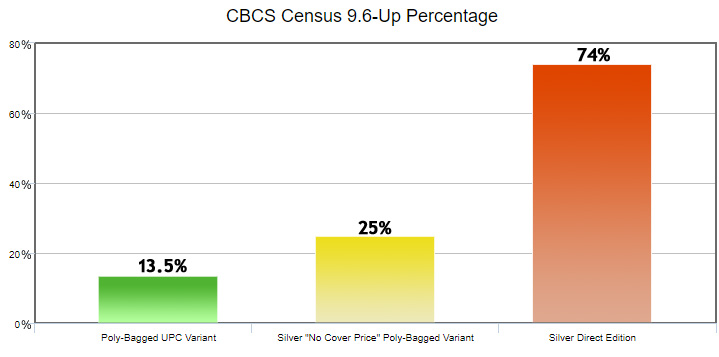
Bottom line: all signs seem to point to first print newsstand sales being “in-line” with the other two poly-bagged “known numbers” (which were 125,000 as per Overstreet), but having been distributed in polybags means that surviving first print newsstand copies are going to face condition challenges. Layer on the rough handling that was typical of the newsstand distribution channel, and the condition challenges are even more steep — as the above CBCS census comparison shows quite glaringly.
Next, let’s review and compare all of the different 1st and 2nd print types that Marvel created for Spider-Man #1 in 1990.
| Green, Silver, Gold, Platinum, Oh My! — A Look At All The Types |
Now that we’ve tackled the “newsstand mystery” as far as the numbers and have come up with a guesstimate, let’s next compare each of the various other types (from 1990 — I’m not going to review the myriad reprints that came later) for Spider-Man #1, and review the print run numbers shared with us by various sources.
First, let’s talk a little further about polybags in general, and what they mean to us as far as comic books being “variants” or not. While it is totally understandable that comic book shops — like Mile High Comics or MyComicShop — would want to have different entries in their systems for polybagged versus unbagged copies of the same version (so that customers know what is going to arrive to them), to me speaking as a collector who likes to send my comics to CGC to be graded professionally, the important criteria that makes for a distinct version is in the printing of a given version, and whether it is distinctly marked / discernible in some way from other types.
Given this view, the idea is absurd and comical to me that that you and I could each start with polybagged newsstand copies of Spider-Man #1, and then do as follows: suppose you decide to submit your copy to CGC inside its polybag and choose the “Poly-Bagged Edition” variant notation on your submission form, along with a note giving CGC permission to snip open the bag; meanwhile I take my copy and I snip it out of the bag, set the bag to the side, and then submit my copy with no variant notation on my submission form. At the end of the day, you will have a first print newsstand copy inside of a slab marked “Poly-Bagged Edition” in one hand, and you will have the empty plastic poly-bag that CGC “maybe” has returned to you in the other hand; and I, meanwhile, will have a first print newsstand copy inside of a slab with no variant notation on the label in one hand, and in my other hand I will have the empty plastic poly-bag I set aside earlier.
Each of us now have newsstand copies that both used to be in poly-bags but are now in CGC slabs. Our two copies are 100% physically identical, and came out of the same print run batch. And yet they carry two different CGC labels. Yet meanwhile, CGC will not tell newsstand and direct edition copies apart with their own census entries and labels?!? To me that’s a situation that can only be described as just plain silly… I think that CGC has it wrong, and should be going by the physical comic itself when creating unique entries.
And when it comes to the physical comics themselves, the following versions exist, as laid out by ComicsPriceGuide, which, in my opinion, among all the various sources I will refer to today, is the one that has organized these in the most logical way (to my way of thinking; and I’m not saying I agree with their guided values, just that I agree with the layout of their entries — although the “purple” color of the webbing of direct edition regular polybagged copies arguably makes them discernible and thus they deserve to have an entry too):

Referring to the above, first, they have the “green” cover copies, which exist as both a direct edition — for which they are estimating over 1,000,000 copies produced — and a newsstand edition (where, like Overstreet, they give no information about the numbers).
Next, they have the “silver” cover, which exists both as a regular direct edition — for which they are estimating over 1,000,000 copies produced — and also the “no price” version (which as we saw earlier was distributed in those polybags with the $2 price on the outside of the bag), which they indicate at 125,000 copies produced (their number matching that of Overstreet).
Next, they have the “platinum” cover, estimated at 10,000 copies produced. Here again they match the information given in Overstreet (which says as follows — and also, their note about new McFarlane art and editorial material instead of ads is a particularly interesting tidbit):

And finally, they have the “gold” cover — correctly identified as the second printing — where they estimate over 450,000 regular direct editions were produced (in-line with Overstreet’s range), and they echo Overstreet in stating a 10,000 (or less) print run for the gold copies with the newsstand UPC codes on them.
In summary:
- Green Direct Edition: 1,000,000+ per CPG
- Green Polybagged Direct Edition: 125,000 (per OPG)
- Green Newsstand/UPC Edition: 125,000 (our estimate)
- Silver Direct Edition Regular: 1,000,000+ per CPG
- Silver Direct Edition No Cover Price: 125,000 (per both CPG and OPG)
- Gold (2nd Printing) Direct Edition: 400,000 to 450,000 (per CPG and OPG)
- Gold (2nd Printing) Newsstand/UPC Edition: 10,000 (per both CPG and OPG)
- Platinum: 10,000 (per both CPG and OPG)
But it is also useful to see how Mile High and MyComicShop break them out into different listings — and from this we actually learn of a few interesting additional things!
Let’s look at Mile High first. For their green cover listings they have entries for both the poly-bagged and unbagged versions, and I found it interesting that for the poly-bagged versions, they list Near Mint newsstand copies at more than double the asking price of Near Mint regular copies in poly-bags:

Similarly, for the Silver listings, they value the polybagged no-cover-price version higher than the regular silver version (and a little under the polybagged newsstand copies):

The Gold listings bring no surprises, except that their asking price for regular gold copies seems extreme relative to that huge print run…
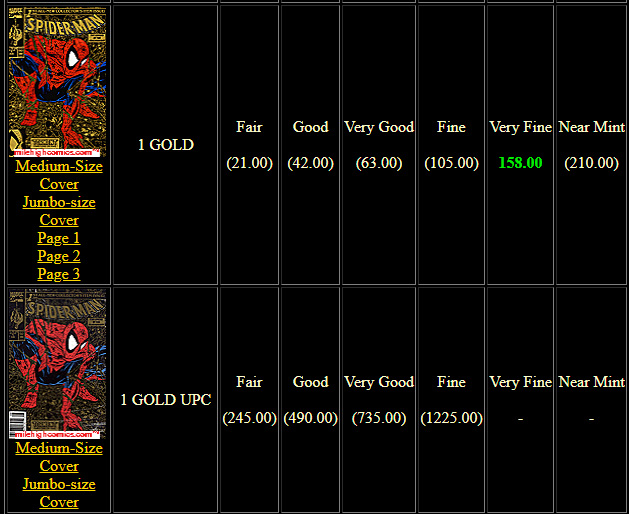
And lastly, the platinum version:

Moving on to MyComicShop, there are a number of additional interesting details among their listings. For one, they have listings for “signed and stamped” versions that may include “a letter of authenticity from Todd McFarlane’s own comic shop he ran back in the 90’s, ‘The Spider’s Web'”:

I found an example copy on eBay complete with the referenced letter. Here’s what the stamp looked like…
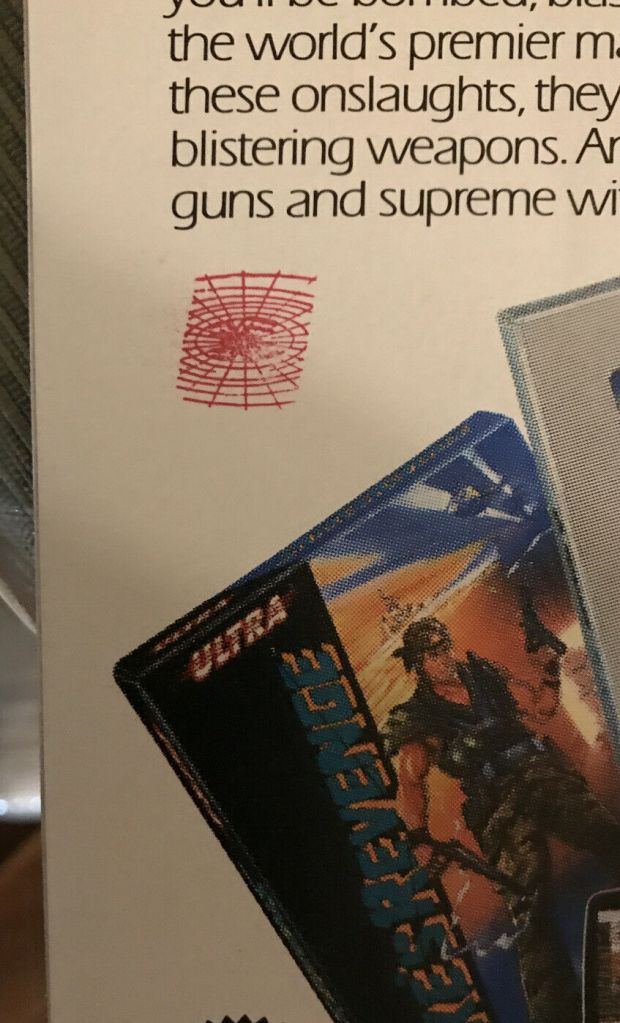
…and this is the “letter” shown in the listing:
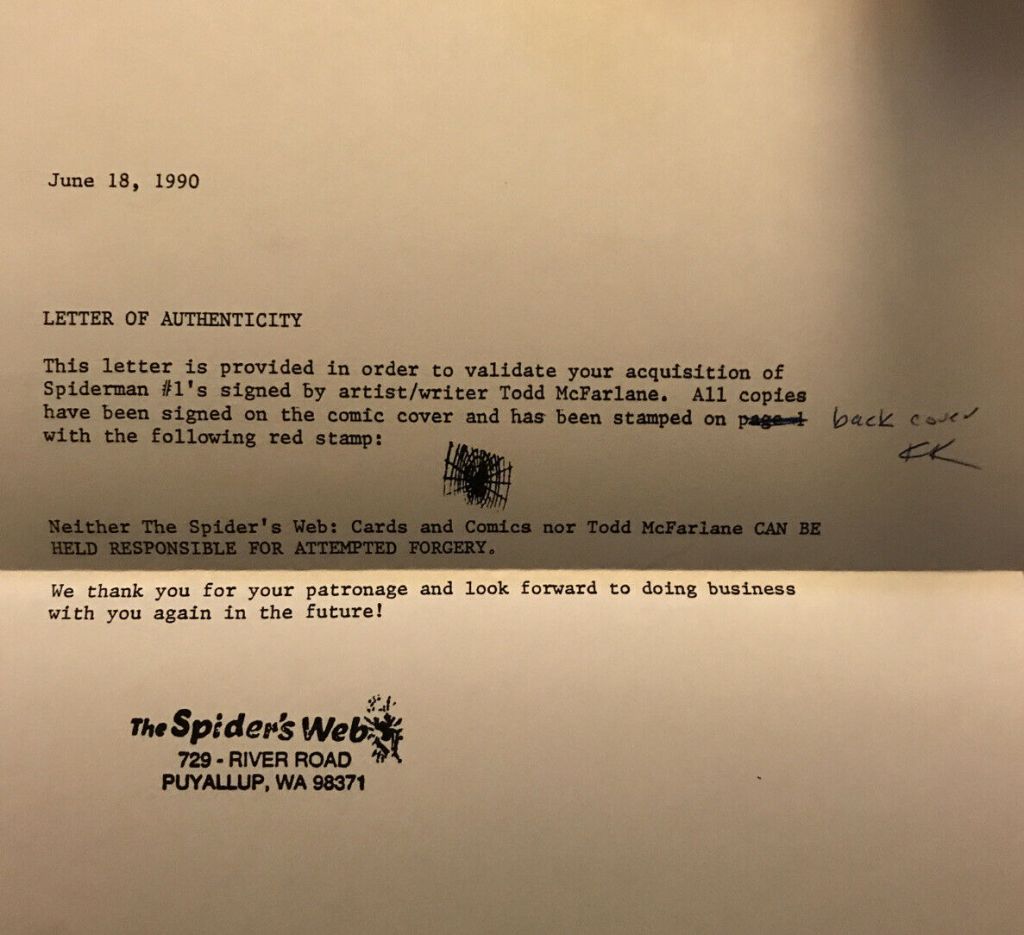
Moving on to MyComicShop’s “regular”/green-cover listings, as expected they have both a polybagged and unbagged listing in their catalog for direct editions…

… and also for newsstand copies:

The listings for Silver cover copies start out as expected:

… but then there is a nifty surprise as well:

Apparently, some unknown number of regular silver copies show the Lizard in blue instead of green on a certain page. I went looking for a copy, and here is the page in question:

While CGC does not recognize these as variants with their own census entries — and this is reminiscent of the Secret Wars #1 “blue Galactus” copies — much like in the case of Secret Wars, CBCS meanwhile does have a variant census entry for these. Here is what a CBCS copy looks like (with a label note that reads: “7th and 10th page color plates transposed”):
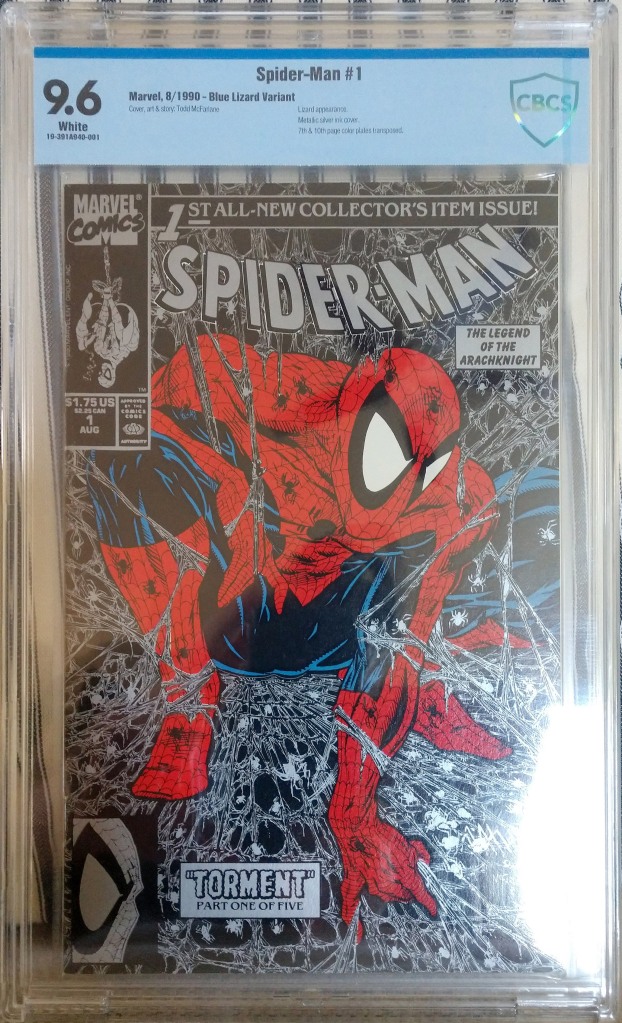
Interestingly, as of this writing CBCS’s census shows ten of these Blue Lizard copies in the top two grades of 9.6 and 9.8, which is a higher count than the six Gold UPC copies on their census, and also higher than the seven UPC Poly-Bag copies on their census, in those same two grade tiers. This relative count makes me question just how many Blue Lizard copies are truly out there? In any case, I think it would be frustratingly hard to try to find these “in the wild” because of the necessity to check interior pages for the error.
Moving on to MyComicShop’s “Gold” cover listings, there is another interesting surprise:

The surprise (to me anyway) is that last entry: at least some number of gold 2nd print direct edition copies were sold in polybags too! How interesting that Overstreet doesn’t mention these given that they do mention each one of the other polybagged types. And why no CGC entry either? If someone was to submit one still in its polybag, then “by precedent” considering how they treat the regular direct editions, shouldn’t they have created a “Poly-Bagged Gold Edition” census entry too? And yet, no such entry appears!
And finally, MyComicShop’s Platinum cover listing:

The platinum copies were distributed to retailers along with the below letter. As you can see, it isn’t so much a “retailer incentive variant” as it is a “thank-you gift variant” after the fact:

Below is an example of what a CGC-graded Platinum copy looks like:
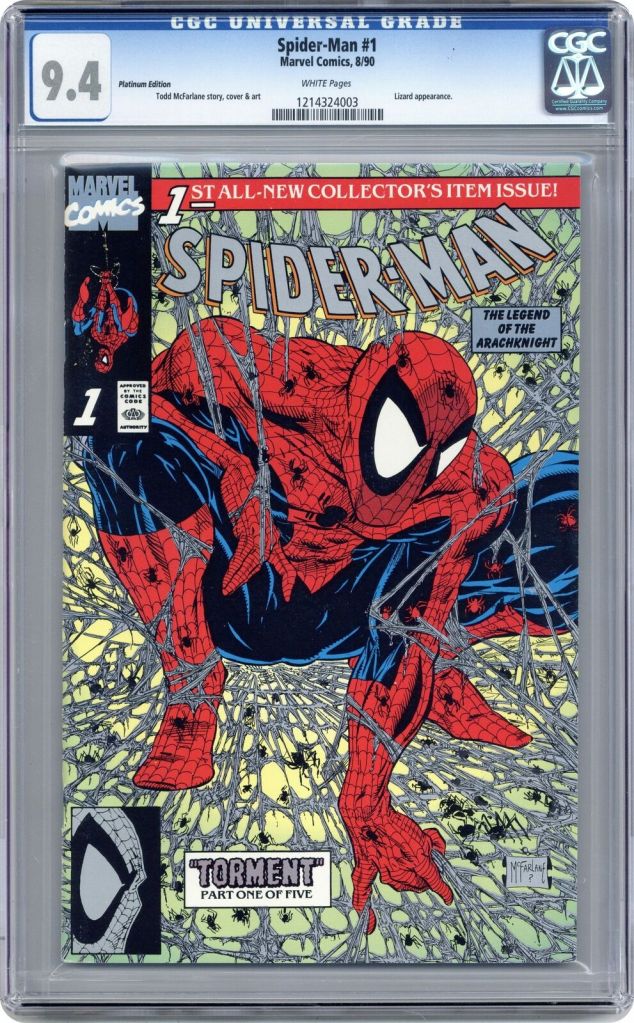
And here’s the back cover of the Platinum version (note the artwork in place of ads):

![]()
Marvel Collectible Classics: Spider-Man
I also want to make mention of the 1998 title, Marvel Collectible Classics: Spider-Man, because eBay sellers will often list issue #2 of that title as “Spider-Man #1 Chromium Edition Variant” or similar. This title re-printed two of McFarlane’s Spider-Man classics, with special chromium wraparound covers: issue #1 reprinted Amazing Spider-Man #300, and issue #2 reprinted Spider-Man #1. Here’s what it looks like, front and back:
Front (based on the Spider-Man #1 cover):

And back (based on the Spider-Man #13 cover):

Since the cover of issue #13 is an homage to the cover of #1, but this time with Spidey wearing the black costume, many Spider-Man #1 “set” collectors also want to collect the original issue #13 from 8/1991 as well when assembling their sets, an issue which exists both as a prevalent direct edition and also with the newsstand UPC code which is far more rare. Here is an example newsstand copy:

Something neat to notice about these #13 copies, is that underneath where McFarlane signed the cover artwork, there is now a number: 71. In the original #1 issue, there was a question mark:
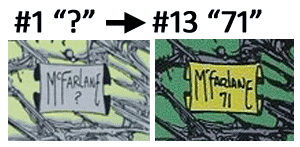
McFarlane famously hid spiders in his cover artwork, sometimes writing the number of hidden spiders next to where he would sign his name on the cover artwork; but for the 1990 issue #1 of Spider-Man, there were so many spiders hidden that he put a question mark instead of a number. Fans rightfully took this as a challenge! Many wrote in with the answer; and then with the issue #13 cover-swipe of #1, in place of the question mark there is now a number — 71, beneath his name.
The CBCS census happens to be much more helpful when it comes to Spider-Man #13 than for #1, because here instead of a mess of different entries, there exist the two expected entries of “Direct Edition” and “Newsstand Edition” which we know are directly comparable to one another, with both starting at the same point in time following their 2017 decision to start recognizing the types distinctly. Comparing the 9.8 grade counts, 87.5% of the current census copies are the prevalent direct edition type, while just 12.5% are newsstand, for issue #13:
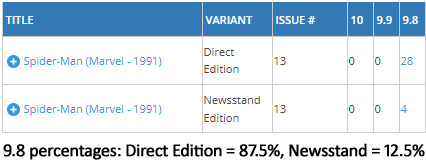
![]()
| Current 9.8 Market Values |
Having now reviewed the various 1990 versions of Spider-Man #1 that you can expect to find in the marketplace, let’s next take a look at recent sales examples. But first, let’s form an expectation of what we’ll see. Based on the known print run numbers as revealed by Overstreet and other sources, and based on our own estimate for the first-print newsstand sales, my expectation would be that if the market is responding to relative rarity then we might see the following relationship:
Starting with the lowest reported print runs, we have a tie between the Platinum and the 2nd print (Gold) newsstand UPC coded copies, at 10,000. Since Platinum copies were presented to comic shops as a “retailer reward/thank-you variant” I’d expect that each and every copy was handled with extreme care once it arrived; the only damage/loss I’d in turn expect would be of the accidental variety (lost in the mail or bent up — which a lot of these were apparently, as they were shipped in simple envelopes like this one, dropped accidentally, etc.).
The UPC coded gold copies, however, were sold to the general public through Walmart. Many would have been read; some would have been thrown out. Thus it seems only natural to me that coming from the same “starting point” of 10,000, we’d end up with fewer surviving gold 2nd print newsstand copies, versus platinum ones. And the current CGC census counts support this notion, with 1,727 platinum copies currently on record at CGC, versus 571 Gold UPC/newsstand copies. Based on this, I’d expect to see the 2nd print (gold) newsstand/UPC coded copies in “first place” when it comes to market value; I’d expect platinum copies in a close second place.
Next, there’s the types at 125,000… The polybagged direct editions I mentally “group together” with the regular/unbagged direct editions because I’m not sure whether the “purple” webbing often seen on polybagged direct editions is actually a physical feature unique to the polybagged version or just a matter of being printed earlier in the run and having a more “rich” color for that reason (anybody know the facts surrounding this? *** UPDATE: thank-you to Ronnie Parisella who reported that purple webs direct edition copies were also available unbagged, and thank-you as well to Chad, the eagle-eyed reader who pointed out that the “purple webs” copies are definitely a distinct print run batch, because they also have a coloring error at Spidey’s knee which none of the other types have (below, look at the circled areas, and at left notice the small coloring “miss” that instead shows the green background)…

…); and it would seem that copies having webbing with regular color shade were also polybagged, judging by this CGC-graded polybagged copy below:

I wouldn’t expect to see the market give any premium to a copy like the above just to know that a copy now living in a slab used to live in a polybag. That leaves the silver “no cover price” type and the first print newsstand copies. I’m going to give the edge to the first print newsstand copies on account of survivorship bias strongly favoring comics that were distributed as direct editions. Thus I’d expect first print newsstand copies in “third place” followed by the no-cover-price silver copies in 4th place.
In 5th place, despite the high CPG value (and Mile High’s high asking prices) I’d expect to see the direct edition 2nd print (gold cover) copies, given the print run at 400,000-450,000, a huge number (but still less than half that of the silver direct edition and green direct edition types). And this just leaves the direct edition regular/green and silver copies in last/second-to-last; I don’t have an expectation of one having notably more value than the other, since both are reported to have had print runs in excess of a million copies, meaning there’s no shortage whatsoever out there of either of those types.
Let’s see how these expectations match the reality, by looking at two of the most recent auction results for each type, in eBay’s “sold” section. As expected, green direct editions in 9.8 don’t seem to be noticeably far apart from silver direct editions, with price differences that can very easily come down to shipping rates and seller preferences:

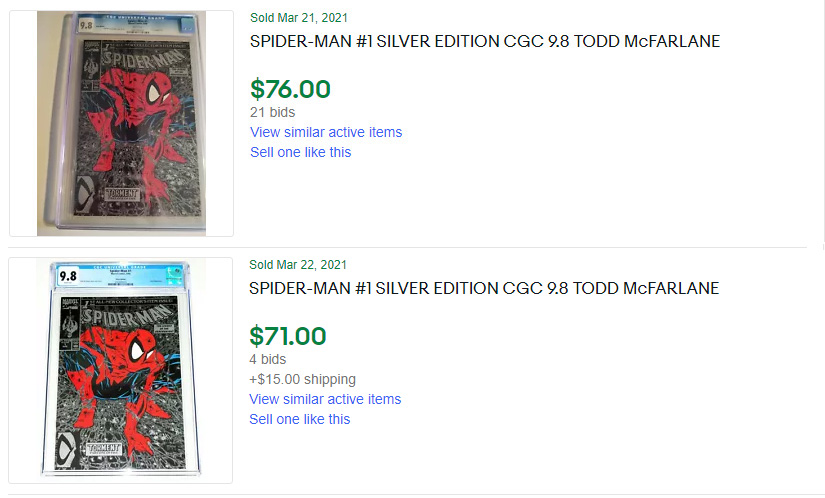
And the market does indeed seem to reward the no-cover-price silver direct editions with a premium over the regular silver copies:

First print newsstand copies do indeed seem to get a market premium, and are the next-strongest among the recent auction results:

But the next result is a surprise to me… beating both the 1st print newsstand copies and the no-cover-price silver copies, are the regular direct edition gold copies! Given the huge print run difference, this comes as a surprise to me (although given the Mile High listing noted earlier, and the CPG guided value, I suppose I should have been prepared for it):

This seems out-of-whack to me, with the gold direct editions looking overvalued to my way of thinking, and the 1st print newsstand copies undervalued by comparison (the no-cover-price silver copies looking undervalued by comparison as well). I realize that gold “seems” better than silver (and better than regular) if you’re ranking by the perceived “level” of the metal, but given the stark difference in print run, I’m still surprised!
With the newsstand/UPC code gold copies we now go up an order of magnitude higher in market value than the types seen so far, with the last two 9.8 sales at auction being these:

And then for platinum copies, I was surprised to find no 9.8 universal grade auction results in the sold listings section at all; the closest results I found were a Signature Series 9.8 (so part of the the market value will reflect the signature value), and a best-offer-accepted result where all we know is that the transaction took place somewhere under the seller’s crossed-out asking price:

[6/2021 update — there have just been a couple of CGC 9.8 platinum copies that sold at auction; while separated in time from the rest of the examples in the post by a few months, I thought it would still be worth posting these as an update:]

And then just in case you were curious, here’s where Marvel Collectible Classics #2 has recently been selling:
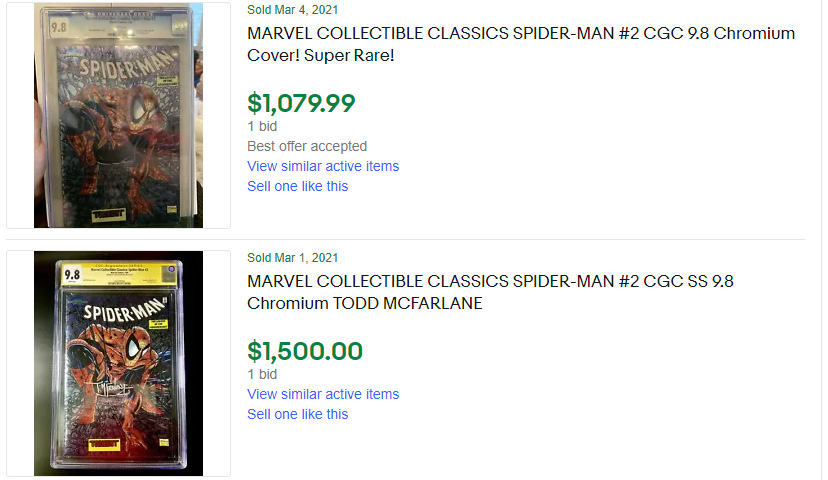
Let’s also take a peek at sales of Spider-Man issue #13 — direct editions in 9.8 are selling not far off from where direct edition regular #1’s have been selling at auction:
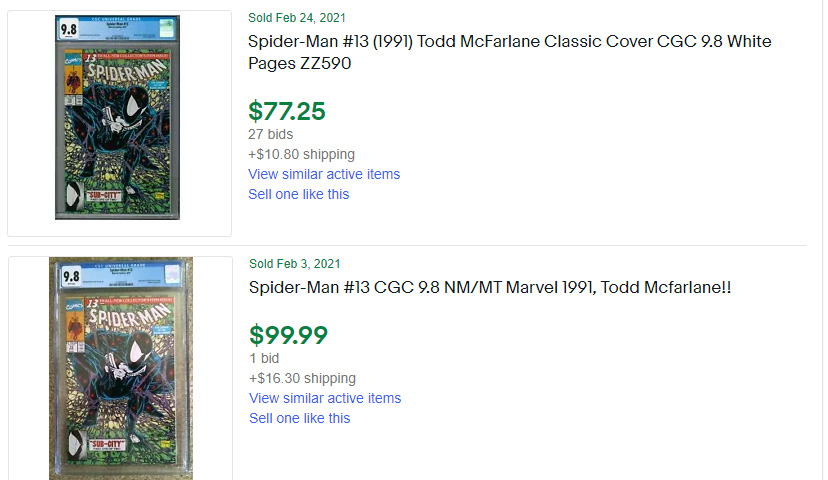
Newsstand copies of #13, on the other hand, are selling at quite a notable premium (and also much higher than newsstand copies of #1):

![]()
| Conclusions |
For those collectors focused on collecting just the most rare versions of Spider-Man #1 from 1990, I think the two clear stand-outs are the Platinum variants sent as a “thank-you” to retailers, and the 2nd print newsstand/UPC coded Gold variants — both of which had the lowest reported print runs among the various types, of 10,000 each.
I also know that there are many collectors out there who like to collect sets and will simply want one of each possible version of Spider-Man #1 from 1990 (and possibly beyond 1990 too). But there are also those of us who look for relative value within the comic book marketplace and act accordingly. And having explored Spider-Man #1 today, I’d argue that what we’ve seen has exposed some strong relative value opportunities.
For one thing, I’d rate both the direct edition green and direct edition silver copies as an avoid — with print runs reported to have exceeded 1 million copies each, to my way of thinking spending $75-$85 on a 9.8 copy of one of these exceedingly-common types is just way too high a price tag for something so common, when that same money (with just a little more on top) could go toward one of the more-rare versions of each of these cover variations: for the silver cover, there’s the “no-cover-price” type which would be my clear preference among the silver copies (and for those who find the “Blue Lizard” copies intriguing one could go after those), and for the green cover variations, I’d strongly prefer the more-rare newsstand/UPC coded copies, which also have such an extremely low 9.8 percentage on CBCS’s census.
In particular, I think the relative value opportunity for first print newsstand copies looks particularly strong because it has a possible future catalyst: if CGC ever were to follow in the footsteps of CBCS and come to embrace newsstand comics as distinct census variants (c’mon CGC, it is way past time to do this!!), then we could go from the current situation — where going by the CGC census alone you might (falsely) conclude that only second print UPC coded copies of Spider-Man #1 exist but not 1st print ones — to a situation where suddenly lots of collectors will check the census and realize that not only do 1st print newsstand copies of Spider-Man #1 exist after all, but their surviving numbers in the highest grades are smaller than the marketplace seems to be giving them credit for!
Happy Collecting! 🙂
– Ben

excellent professional collecting insight, thank you for your collecting knowledge.
LikeLike
Great piece. There was no Gold Poly Bagged Edition though. That book is a fake, was never released originally and should not have been sold by MyComicShop.com. If anyone would like to see the biggest, broadest & sexiest SM#1 collection in the Multiverse, take a deep breath, then click here………..https://photos.app.goo.gl/s9yhR1rLgMFc6j7r6
LikeLike
WOW Ronnie, what a stunner of a collection, Bravo to you!!! 🙂 Thanks so much for sharing that intel on the Gold poly-bagged edition — can I ask, for clarity: Is that a hypothesis that any Gold copies we see on the marketplace inside of polybags are fakes? Or, was the copy sold by MCS publicly exposed to be a fake (like perhaps the buyer scrutinized the polybag and found evidence it had been opened and re-sealed, and posted that evidence online)?
I notice that an eBay listing advertising a Gold polybagged copy recently sold in June; here is a link to it, the seller was Pop Culture Comics out of Pittsburgh (from a Google search this appears to be an actual brick-and-mortar store):
https://www.ebay.com/itm/124759843151
They described it as:
“Spider-Man #1 | Gold 2nd Print | Ultra Rare Polybagged | Marvel 1990 | McFarlane.
Polybag is factory sealed, unopened
In our opinion this book appears to be 9.0 or better, Please check all photos carefully to make sure condition and contents meet your expectations.”
And since eBay will eventually purge the listing and its pictures from their system, I’ve uploaded the listing’s pictures and will include them here at the end of this comment, for posterity. Ronnie, based on what you see in these pictures and the listing link, do you expect that this is a fake? (And how are they accomplishing and getting away with it?)
I checked to see if the buyer had left any negative feedback on the transaction, and actually they were happy with it and left a positive, so, if this was indeed a fake, then it was a good enough one to have fooled the buyer into believing it was legitimate.
Any further details you can give to explain what you know about these (and why you state they are fake) would be greatly appreciated!!
And while I’ve got your ear, given your extensive first-hand experience collecting Spider-Man #1’s, can you weigh in on something on a different topic that I’ve been trying to figure out? “Green” background Direct Edition copies sometimes have webbing that looks more “silver” in color shade, and, sometimes they have webbing that looks more “purple” in color shade.
A hypothesis I’ve been trying to explore is whether the “purple web” copies only originated in polybags. I notice that some of your CGC-graded copies with what looks to me to be the purple webbing do not say “Polybagged Edition” on the label… which would imply that those particular copies started life as regular unbagged direct-sold comic shop copies… But on the other hand, they might also have originally been in bags but opened before submission?
Any chance you have any insights into this “purple webs” phenomenon (and whether the hypothesis that these “purple web” copies were exclusive to polybags holds any water)?
Thanks Ronnie! Best,
– Ben
(And below for posterity are the listing pictures from the aforementioned recently-sold “Gold polybagged” copy sold on eBay last month).
LikeLike
Hey Ben, sorry I missed this earlier.
Gold Poly-Bagged:
Marvel has never had a public record or solicitation for sale of a Gold Poly-Bagged book. Both Gold (UPC and Direct) were 2nd Print copies and were never offered bagged. It’s 100% fake, and anyone arguing it is real was either duped or trying to make money. The Gold Direct had a print fun of 500K, and the Gold UPC was said to have a print run “Less than the Platinum” (10,000).
If we do a deeper dive on the print runs and graded copies of both, it’s quite interesting:
– Platinum – 10,000 copies printed – 1,809 Graded
– Gold UPC – Less than 10,000 copies printed – 599 Graded
3x less copies graded could mean a 3x lower print run (my estimate is 4,000 copies printed). Or, the lower graded count could account for the fact that the Gold UPC books were sold at Wal Mart only, without bags or boards. They likely didn’t get treated as the “1st All New Collectors Item Issue” Typically, newsstand copies sold at retail (non-comic shop locations), and were sometimes printed on lower quality paper.
I believe the Gold UPC is the rarest original SM#1 book out there, by far, despite Platinum commanding premium prices (it is much better looking, overall).
The Great Green Cover Debate:
This is a real one that I have been fighting for some time.
CGC only recognizes 7 “Editions” of Spider-Man #1 from 1990:
1. Green
2. Gold
3. Platinum
4. Poly-Bagged Edition
5. Poly-Bagged Silver Edition
6. Silver Edition
7. UPC Gold Edition
I, however consider there to be 9 OG printings, and 3 misprints.
1. Green Cover w/Purple Webs (1MM Print Run) Same as below
2. Green/Yellow w/Silver Webs (1MM Print Run) Same as above
3. Poly-Bagged Edition Direct (Green w/Purple Webs) (125K Print Run)
4. Poly-Bagged Edition UPC (Green/Yellow w/Silver Webs) (125K Print Run)
5. Silver Edition
6. Poly-Bagged Silver Edition (125K Print Run)
7. Platinum Edition (10K Print Run)
8. Gold Edition (2nd Print, 450K Print Run)
9. Gold Edition UPC (<10K Print Run)
10. MISPRINT: Silver Edition – Blue Lizard Variant (Unknown Print Run)
11. MISPRINT: Silver Edition – Copper Lizard Variant (Unknown Print Run)
12. MISPRINT: Silver Edition – Bottom front cover not aligned.
This is because:
– The Green Cover with Purple Webs Direct was in both the Un-Bagged and Poly-Bagged versions. I have seen and verified both.
– It looks like there could be/actually are 6 different original versions of the Green cover, but in actuality, there are only 4. The Green/Yellow Cover UPC was only Poly-Bagged, there was no Green/Yellow Cover UPC Un-Bagged.
(Note: If you don't send the Poly-Bagged book to CGC in perfect sealed condition, they will note the book as the un-bagged version. This adds to the confusion.
My list above is the definitive list (as of now, ha) and should be used as a reference. I am always trying to update it, so if new data comes to light, I will use it.
Please feel free to come by my SM#1 Facebook Page, appropriately named:
https://www.facebook.com/groups/doomdoomdoom
Ronnie
LikeLiked by 1 person
This is a great read. Just going through my variants and pondering this whole thing. I have the gold direct, the silver direct, the silver polybagged no price, the green polybagged newsstand, the green direct and one that is confusing. It’s a green polybagged direct with purple webs but it’s the one with a small part of spideys right knee under the price not colored in. Zero idea where that fits in the mix. How many did they print before they saw the mistake and fixed the plate? You know anything about this variant? I have three still bagged.
LikeLike
Hi Chad, thanks for reading and commenting! An eagle eye you’ve got there — I had not noticed the small part of Spidey’s knee not colored in properly, on the purple webs copies. For others who may be reading this, here’s a zoom-in, with a “purple webs” copy at left and a more-silver-webs direct edition at right:
Chad, I just opened about 50 purple webs listings to check them and I actually don’t see any that are correct, i.e. every purple webs copy I just reviewed also has the ‘knee problem’ … so if there exists a purple webs batch with a correct knee I’ve yet to see a copy out of that batch. Possibly the whole run of purple webs copies also has the not-fully-colored-in-knee?
– Ben
LikeLike
I recently dug out my long box from when I was a kid and found my SM #1 from 1990, silver edition. I noticed that the bottom edge of the front cover appeared to have an error as the silver ink is not there all the way across the cover’s bottom edge about 1/4” the whole way. So, I guess I happen to be in possession of your #12 error. I can’t really find much online about this other than your article and wondered if you had any insight on an estimated value? I plan on sending to CGC but, considering if I should drive the hour to Sarasota and hand it to somebody, or just mail it in. Haha. Thanks!
LikeLike
Hi.
I have another possible variant in which the Lizard is pages are correct but Peter Parker parker is Yellow/Copper on a couple of pages.
Anyone come across this misprint before?
LikeLike